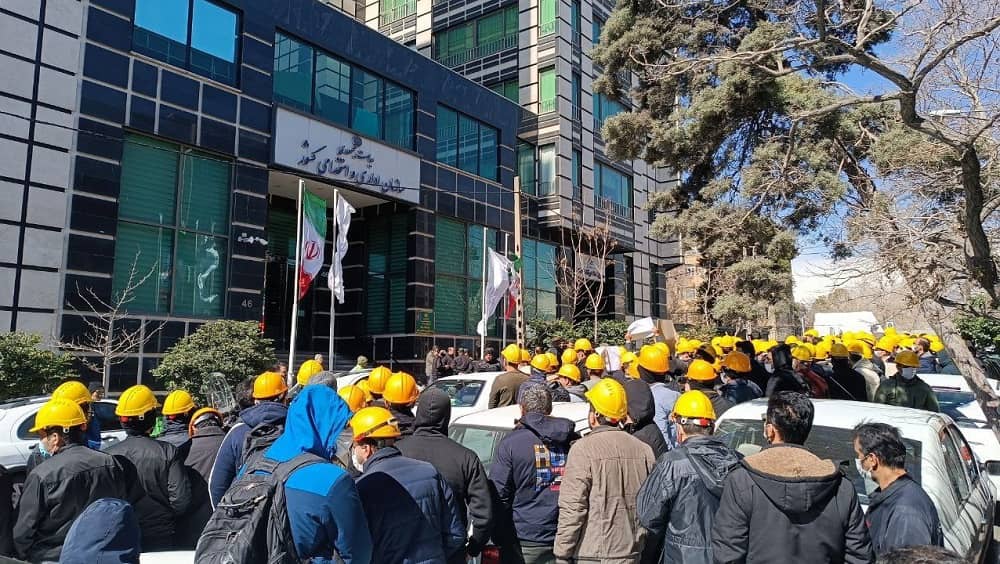Facebook
Twitter
LinkedIn
Pinterest
Reddit
Email
Print
 March 1 – Tehran, Iran: Power sector workers protest for full-time contracts and equal benefits
March 1 – Tehran, Iran: Power sector workers protest for full-time contracts and equal benefits
Iran is witnessing a new wave of protests as workers, nurses, retirees, and residents across multiple provinces take to the streets, demanding economic relief, transparency, and an end to systemic corruption. The protests, which have been met with repression in some areas, reflect growing frustration over inflation, poor working conditions, and mismanagement of public resources.
Workers at Iran’s power transmission and distribution sector gathered outside the Administrative and Employment Organization in Tehran, the nation’s capital, demanding full-time employment contracts and equal benefits. Many of these workers have remained in contractual limbo for years, facing discriminatory treatment compared to officially hired employees.
Workers in the Nar and Kangan operational zone in southern Iran staged a protest march, denouncing mismanagement by contractors, economic hardship, and wage discrimination. The demonstrators, composed of third-party contract workers, voiced their frustration over deteriorating living conditions and workplace injustices. Their key demands included salary adjustments in line with inflation, the elimination of middlemen contractors, and the full implementation of a job classification system. Protesters chanted “Enough with the promises, our tables are empty!” and “Shout for your rights—justice, justice!” as they marched, signaling widespread discontent with the government’s failure to address labor grievances.
March 1—Kangan, southern Iran
Contract workers of the oil and gas industry resume protests as authorities continue to ignore their demands for basic needs.
“Enough with the promises, our tables are empty,” protesters chant.#IranProtestspic.twitter.com/h76oCNm1hs
— People’s Mojahedin Organization of Iran (PMOI/MEK) (@Mojahedineng) March 1, 2025
In Isfahan, central Iran, nurses at Chamran Hospital held a protest on March 1 over low wages and deteriorating working conditions. Chanting “Shout for your rights!”, they condemned the meager compensation for overtime work and the lack of job security.
On the same day in Kangan, southern Iran, contract workers in the oil and gas industry resumed their demonstrations after repeated unfulfilled promises from authorities. “Enough with the promises, our tables are empty!” they chanted, highlighting the economic struggles they face despite working in one of the country’s most critical industries.
In Shahrekord, Chaharmahal and Bakhtiari Province, western Iran, nurses staged another demonstration on March 1 outside the governor’s office, demanding wage increases and improved working conditions. The protest was disrupted by security forces, who reportedly threatened participants and forced them to disperse.
On February 28, citizens in Bukan and Miandoab, West Azerbaijan Province, northwestern Iran, blocked a major highway in protest against the increasing number of deadly road accidents in the region, demanding urgent government intervention to improve infrastructure.
March 1—Isfahan, central Iran
Protest rally by nurses of Chamran hospital. “Shout for your rights,” protesters chant.#IranProtestspic.twitter.com/tQPJMCJWhd
— People’s Mojahedin Organization of Iran (PMOI/MEK) (@Mojahedineng) March 1, 2025
In Neyshabur, northeastern Iran, frustrated applicants of the government’s National Housing Plan gathered to protest severe delays in the completion of promised housing units. One protester stated, “We registered two years ago and paid the required fees, but our homes are nowhere to be seen, and no one gives us answers.”
Environmental protests also took place on February 28 in Alavijeh, Isfahan Province, central Iran, where residents held their weekly demonstration against local mining operations that have caused extensive environmental damage. Protesters carried banners that read “Protecting the environment is protecting life!”, calling for an immediate halt to destructive excavation projects.
On February 26, retired employees of Iran Air (HOMA) staged a demonstration outside the Ministry of Labor in Tehran, protesting the government’s mismanagement of pension funds. Protesters accused officials of illegally transferring airline assets to state-controlled conglomerates, jeopardizing the financial security of 10,000 current employees and 13,000 retirees.
Economic hardship remains at the center of public frustration. Reports indicate that this year’s pre-New Year shopping season is among the worst in recent memory due to soaring inflation and unaffordable prices. Interviews with local residents paint a dire picture:
“The market is dead; people can’t afford anything.”
“Prices keep rising, and no one has money to spend.”
“It’s worse than previous years—there’s no demand, no business, and even power outages make things worse.”
Meanwhile, the cost of housing has reached record levels. According to a state-affiliated report, Iran’s rental inflation surged to 41% in February, marking the highest rate in 13 years. This crisis has placed severe financial strain on six million renting households across the country.
Adding to the turmoil, natural disasters have further exposed government inefficiencies. On February 25 in Zahedan, Sistan and Baluchestan Province, southeastern Iran, a three-year-old girl and her mother were killed when a wall collapsed due to severe storms. The following day, heavy dust storms and high winds of up to 76 km/h hit Khash and Mirjaveh, toppling 12 power transmission poles and leaving many areas without electricity. Despite the devastation, authorities have provided little to no emergency relief.
The mounting protests and worsening economic conditions highlight the deepening public anger toward the government’s mismanagement. With discontent spreading across various sectors, the regime faces increasing pressure as citizens continue to demand justice, economic relief, and accountability.